Shoulder-launched multi-purpose weapons can be used against a wide range of targets. Miniaturisation and weight savings, modularity, longer ranges as well as more versatile and greater effect, further network capability and artificial intelligence determine procurements and further developments. In addition, the urbanisation of the battlefield has increased the importance of their use from confined or enclosed spaces.
Modern shoulder launched munitions (SLM) are essentially intended to serve the following purposes: engaging armoured combat vehicles up to the latest generation of Main Battle Tanks; destroying cover such as buildings and other structures; engaging targets in defilade; engaging assembled infantry; battlefield illumination; and interruption of the enemy line of sight.
Consequently, unguided and guided weapons of this type follow a modular design. This includes ammunition, firing equipment, iron or optical sights, including night vision and, if necessary, fire control systems. For guided missiles, optics and fire control system are housed in a Command Launch Unit (CLU). Even for light disposable weapons, adaptable reflex sights, laser sights or fire control units are now available. Irrespective of this, there are two basic conceptual approaches, especially in the category of unguided shoulder-launched multi-purpose weapons: reusable launchers or disposable weapons.
From Anti-tank Rifles to Multi-purpose Weapons
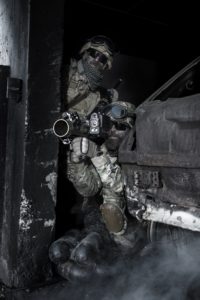
The RPG-7, one of the most widely used weapons of its kind in the world to this day, serves as a reusable launcher. The ‘Ruchnoy Protivotankovyy Granatomyot’ (hand-held anti-tank grenade launcher; often incorrectly translated as ‘Rocket Propelled Grenade’) has undergone numerous modifications since its introduction in 1961. The Russian Armed Forces currently carry the RPG-7V2 variant. In addition to shaped charge (PG-7VL) and tandem shaped charge (PG-7VR) projectiles, thermobaric (TBG-7V), fragmentation (OG-7V) and anti-structural warheads (GSh-7Vt) are also available as ammunition. The RPG-7 has several modernised licensed replicas, including the PSLR-1 manufactured by the US company Airtronic.
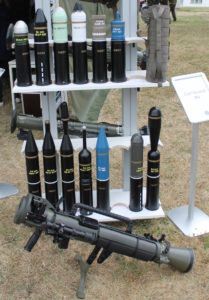 The larger calibre RPG-29 VAMPIRE, introduced in 1989, fires the tandem PG-29V shaped-charge warhead. It can penetrate explosive reactive armour (ERA) and is said to have taken MERKAVA 3 and CHALLENGER-2 tanks out of action during the wars in Lebanon and Iraq. For the RPG-29, the TBG-29V thermobaric warhead is also available.
The larger calibre RPG-29 VAMPIRE, introduced in 1989, fires the tandem PG-29V shaped-charge warhead. It can penetrate explosive reactive armour (ERA) and is said to have taken MERKAVA 3 and CHALLENGER-2 tanks out of action during the wars in Lebanon and Iraq. For the RPG-29, the TBG-29V thermobaric warhead is also available.
The US Armed Forces have had the Mk-153 Shoulder Launched Multipurpose Assault Weapom (SMAW) in their arsenal since 1984. It fires assorted 83mm calibre munitions. The weapon has been modernised several times by Raytheon and Nammo, with the latest, lighter-weight SMAW II SERPENT using a more modern fire control sight. Modernised ammunition types are also available.
The 84mm CARL GUSTAF, developed in the late 1940s, is used by over 40 countries. In October 2014, Saab Defence presented the latest generation CARL GUSTAF M4. As a result of the extensive range of ammunition that can be fired from the launcher, which can be equipped with fire control sights, the ‘CGM4’ is suitable for almost all target scenarios. The CGM4 now weighs less than seven kilos and measures less than one metre. Other significant improvements include modernised ergonomics, an integrated shot counter and faster operational readiness as the CGM4 can be carried safely while loaded. The range is just over 1,000 metres against semi-hard targets.
The slightly longer and heavier predecessor model, M3, already serves the US armed forces as the M3 Multi-Role Anti-Armor Anti-Personnel Weapon System (MAAWS). In October 2018, the US Army announced the procurement of the CGM4 as the M3E1. Saab and Raytheon also received an order to develop a new guided munition for the CARL GUSTAF. This is to have a range of around 2,000 metres and can also be used against moving targets. In 2019, the US Armed Forces signed a framework agreement with Saab worth US$ 445M for the supply of CARL GUSTAF and AT4 ammunition.
The Spanish company INSTALAZA offers its C90-CR Reusable launcher in this segment. The empty 3.9 kg launcher can load with anti-tank, multi-purpose, smoke, anti-structure and explosive/fragmentation projectiles. Maximum range is up to 700 metres against area targets. At 350 metres, the anti-tank round can penetrate up to 480 mm RHA.
For Single Use
Instalaza also offers its CR-90 disposable ammunition in its range. Depending on the type of ammunition (anti-tank, multi-purpose explosive/fragmentation, smoke, antistructure) the weight is plus/minus five kilogrammes. The disposable weapons can also be used on moving targets at 350 metres and against area targets at up to 750 metres. The anti-tank variant can penetrate up to 400 mm RHA.
Saab’s AT4 CS family is disposable too. The AT4 CS also has the 84mm calibre. CS stands for ‘Confined Spaces’ and indicates the possibility of using the weapon out of confined spaces. Saab currently offers the following versions of the AT4 CS: ER (anti-armour extended range), HP (high performance, higher penetration of more than 500 mm RHA), RS (reduced sensitivity, anti-tank warhead for urban or jungle combat), AST (anti-structure and breaching) and HE (high explosive anti-personnel). This ammunition family is to be fused more closely with the CGM4. The AT4 CS family is in use in more than 15 countries. The US Army introduced the weapon as M136A1. In December 2014, the French Armed Forces ordered Saab and Nexter to supply different types of AT4 CS as the ROQUETTE NG weapon system.
Somewhat smaller in calibre – 66 mm – is the Nammo M72 family, which is based on the compact M72LAW disposable bazooka of the US Army. This handy disposable weapon is now available in many versions, including anti-structure variants that can be fired from enclosed spaces (FFE – fire from enclosure). The M72E11 Mk2 is also available as a programmable version with airburst function.
In recent years, the traditional Russian weapons group KBP from Tula has introduced two handy grenade weapons made of disposable cartridges with a reusable grip. The RPO-M PDM ‘SHMEL’ (‘Bumblebee’) is an improved version of the thermobaric RPO-A introduced at the end of the 1980s. Calibre and weight were reduced. The effective range was supposedly increased to up to 1,700metres.
The 62mm Malogabaritnyy Granatomyotnyi Kompleks MGK ‘BUR’ (compact grenade launch system ‘Drill’), which was first shown in the West at Eurosatory 2014, is even more handy. The disposable launch tubes contain either thermobaric or explosive/fragmentation grenades, and its effective range is 650 metres.
The Modular Davis Gun Family
The more recent KBP designs follow a similar technical concept to the PANZERFAUST 3 and Recoiless Grenade Weapon (RGW) families from Dynamit Nobel Defence (DND). These consist of disposable cartridges with separate or integrated firing devices depending on the design, as well as optics or fire control units. The weapons work according to the Davis gun principle with countermass. Due to the resulting low backblast zone, they can be used from rooms and in confined environments.
Various shoulder-launched weapons from DND in calibres of 60mm and 90mm are used, for example, in the Bundeswehr. The German Special Forces use the RGW60 as PANZERFAUST, LEICHT in 60mm calibre. It is available in three versions: shaped charge (HEAT, DM52), shaped charge/fragmentation (HEAT-MP, DM42) and High Explosive Squash Head (HESH, DM62).
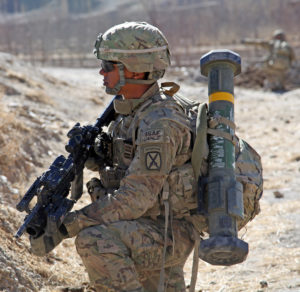
The DND PANZERFAUST 3 serves as the standard bazooka in the German Bundeswehr. Meanwhile, DM72A1 cartridges of the latest PANZERFAUST 3-IT type have been procured. ‘IT’ stands for ‘Improved Tandem’. With its tandem shaped charge, the PANZERFAUST 3-IT is capable of defeating highly protected Main Battle Tanks in motion at up to 400 metres, with reactive additional armour. If the Hensoldt DYNARANGE fire control sight is used, the effective range may increase to 600 metres.
The PANZERFAUST 3 is currently being adapted for the more modern DYNAHAWK fire control sight. At the same time, DYNAHAWK serves as the optics for another versatile system from DND, namely the RGW 90 family. With the former ‘Area Denial’ (AD) and now Long Range Multi Purpose (LRMP) cartridge, the gunner can programme the warhead in three different versions through the DYNAHAWK fire control sight before firing: impact with and without delay and air burst mode. In service with the Bundeswehr as the WIRKMITTEL 90, the RGW90 can fire programmable multi-purpose warheads (DM11 explosive/fragmentation with impact mode/air burst mode and DM22 anti-structure ammunition with blast or mousehole effect). In airburst mode, the range is up to 1,200 metres. In addition, the Bundeswehr has procured cartridges with smoke (DM15) and IR illumination (DM16) as well as DM18 training munitions. DND, as the system leader, is responsible for the launch tube and warhead, Heckler & Koch manufactures the firing unit and Hensoldt the fire control sight with the DYNAHAWK designation. Rheinmetall manufactures the training munitions, the illumination cartridge and the smoke cartridge for the RGW 90 AD. In addition, DND currently also offers the HH (HEAT/HESH) and HH-T (HEAT/HESH Tandem) cartridges for its RGW 90 family. Furthermore, the company continues to develop its weapon family. For example, the RGW110 has integrated the 110mm warhead of the PANZERFAUST 3 into a cartridge the length of the RGW90.
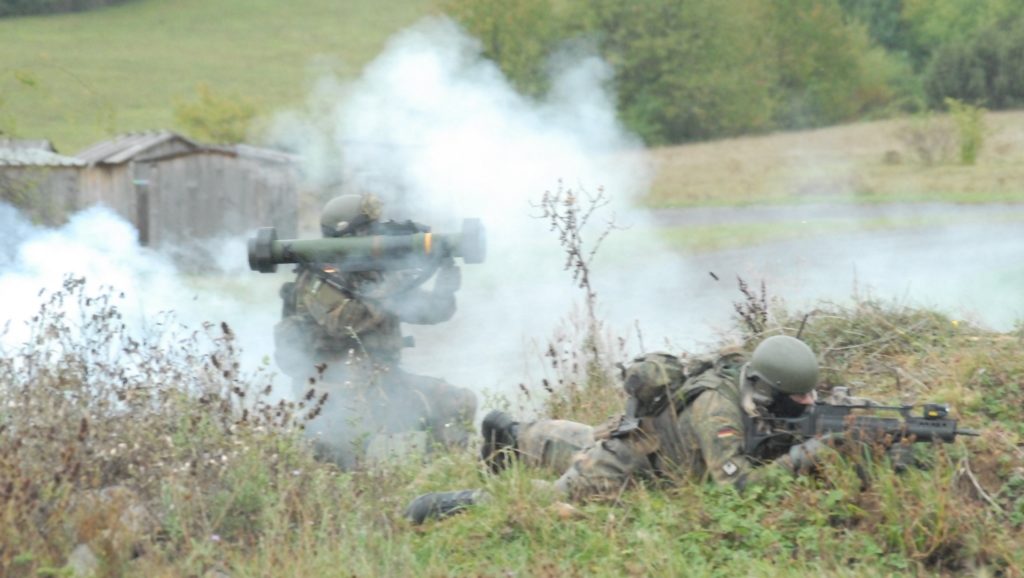
INSTALAZAS ALCOTAN-100 (M2) brings it to a calibre of 100mm. Depending on the type of ammunition, this plus/minus 10kg heavy weapon also works with countermass and can be fired from confined spaces. The system consists of the reusable VOSEL-2 fire control unit and disposable launch tubes. Anti-tank, multi-purpose explosive/fragmentation and anti-bunker cartridges are available. The maximum range is 600 metres against point targets and 1,000 metres against area targets. The anti-tank projectile penetrates up to 700mm behind ERA.
Multi-role Guided Missiles
Guided missiles, which were originally optimised for pure anti-tank warfare, had to be modernised in view of developments in protective technologies. The optional Overfly Top Attack (OTA) capability, which is available in addition to Direct Attack (DA), is now the standard. In addition, guided weapons can now be used against a wider range of targets. In many cases, the operator still controls the guided missile semi-automatically through line of sight (Semi Automatic Command to Line of Sight, SACLOS), whereby the missile receives its signals through wire, radio, laser or radar. The latest ATGMs can transmit the shooter the image of their seeker head’s sensors to the Command and Launch Unit (CLU) in real time. This enables ‘Beyond Line of Sight’ (BLOS) operations. Fire, Observe and Update, Fire and Forget or Predicted Line of Sight (PLOS) are also represented. The latest guided missile systems usually offer several different operating methods. Furthermore, modern CLUs offer better day and night vision capabilities while being more compact and lighter.
Saab offers its Next Generation Light Antitank Weapon NLAW in this spectrum. A fire-and-forget disposable weapon, it was developed for the Swedish and British Armed Forces, but is also in use in Finland. The 12.5kg NLAW can be deployed by a single soldier from enclosed spaces. It operates with a Predicted Line Of Sight (PLOS) control. The shooter can also choose between DA and OTA mode depending on the target. The range is up to 800 metres.

The Serbian BUMBAR (“Bumblebee”) is also designed for short ranges. Its design is based on the French-Canadian development ERYX. BUMBAR is equipped with a 136mm tandem warhead that is designed to penetrate 1,000mm ERA. The effective range is 600 metres, while a version with a range of 1,000 metres is being considered for development.
The current version two of the RBS-56 ‘BoforsInfantry Light and Lethal’ (BILL) from Saab Bofors Dynamics features OTA capability and can penetrate reactive armour due to two warheads. It also has a semi-hard target mode. BILL-2 offers a range of 2,200 metres.
For one of the most widely used guided missiles, MILAN, MBDA has developed the improved version MILAN ADT-ER. It features improved day and night vision and a significant reduction in weight and noise.
The French Armed Forces are currently introducing MBDA’s Missile Moyenne Portée (MMP, Medium Range Missile). It has a range of up to four kilometres and operates according to the ‘fire and forget’ principle, but also permits ‘operator–in-the-loop’ procedures. Target engagements beyond direct line of sight by means of a network-centric enabled tablet computer, or through images relayed by micro-UAVs, were also demonstrated during a live firing demonstration in November 2018. The MMP can be used both from portable firing systems and from combat vehicle weapon stations. Despite its high effectiveness against a wide range of targets – including Main Battle Tanks with ERA armour – the MMP should largely rule out collateral damage, not least because of its precision.
MBDA offers the new small guided missile KLEINFLUGKÖRPER – KFK ENFORCER – for infantry and special forces, especially for the German project ‘LeichtesWirkmittel 1,800 Meter+ (LWM 1,800+, lightweight effector 1,800metres and more)’. With a calibre of 90mm, it is intended to supplement the WIRKMITTEL 90 family used by the Bundeswehr. The KFK ENFORCER, which can be operated by just a single soldier, uses the same fire control sight as the other ammunition in this system. The range is 2,000 metres. Equipped with fire-and-forget capability and also useable from enclosed spaces, the ENFORCER’s programmable warhead allows it to be used day and night against a variety of targets, including lightly armoured vehicles, sniper positions and shelters. In this segment, Eurospike (a joint venture of Rafael, Diehl and Rheinmetall) offers a version of the SPIKE SHORT RANGE (SR). The lightweight SPIKE SR is also fire-and-forget with day and night combat capability. Its operational range is between 50 and 2,000 metres. Anti-tank, anti-structure and fragmentation warheads are available. The lightweight SPIKE SR is also ‘fire-and-forget’ with day and night combat capability. Its operational range is between 50 and 2,000 metres. Anti-tank, anti-structure and fragmentation warheads are available.
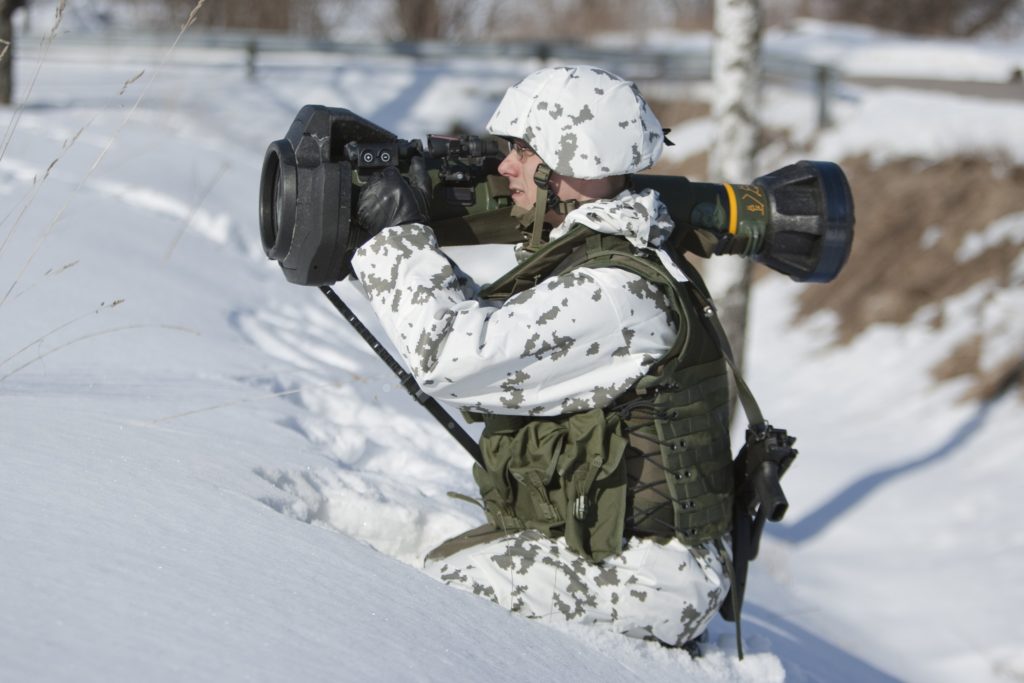
Eurospike is also supplying a further member of the SPIKE family, the SPIKE-LR (Long Range) guided missile, to the Bundeswehr as the ‘Mehrrollenfähiges Leichtes Lenkflugkörpersystem (MELLS, multi-role lightweight guided missile system)’. MELLS can be used both mounted and dismounted. The SPIKE-LR can be used against armoured targets at distances of up to 4,000 metres. SPIKE LR also works against bunkers and mortar and artillery positions. Both ‘Fire and Forget’ and ‘Fire, Observe and Update’ are possible, so the shooter can change targets even after firing or can engage targets behind cover. Likewise, the SPIKE LR can receive its target co-ordinates over a network and then engage using the Non-Line-of-Sight procedure, without seeing the target. MELLS has already been integrated into the MARDER 1A5 infantry fighting vehicle and is currently being integrated into the PUMA infantry fighting vehicle and the WIESEL. SPIKE LR2 is a modernised version with a range of 5,000 metres.
Another latest-generation system, the OMTAS from Rocketsan, originates from Turkey. Series production began in 2018. The day and night combat capable OMTAS has both ‘Fire and Forget’ and ‘Fire and Update’ capabilities and a range of 4,000 metres. Both DA and OTA are possible. With its 160mm tandem warhead, it should be able to penetrate 1,000mm ERA. The system will soon replace MILAN and BGM-71 TOW in Turkey.
BGM-71 TOW and FGM-148 JAVELIN are among the other common western guided missiles. Today both come from Raytheon. The latest anti-tank effectors of the TOW, BGM-71 E (TOW 2A) and BGM-71 F (TOW 2B) are equipped with a tandem warhead and an OTA warhead respectively, which forms two Explosively Formed Projectiles. JAVELIN is a ‘Fire and Forget’ weapon that can engage its targets directly or through top attack. JAVELIN reaches its out-of-service-date in 2021. Raytheon is currently working on the successor generations, FGM-148 F with multi-purpose warheads and FGM-148 G, a modernised version with higher efficiency and better control with lighter weight.

With its BAKTAR SHIKAN developed in the mid-1990s, Pakistan has a 2nd generation anti-tank guided missile in use. It is based on the Chinese HONGJIAN HJ-8 with a range of 3,000 metres and a tandem warhead that penetrates up to 600 mm ERA.
Anti-tank guided missiles developed during the Warsaw Pact era have also undergone continuous improvement. Models such as the 9M113M KONKURS (NATO designation: AT-5B SPANDREL B, now with tandem warhead and 4,000 m range) or the 9K115-2 METIS-M (NATO designation: AT-13 SAXHORN 2, 130mm calibre, tandem HEAT or thermobaric warhead, up to 2,000 metres range) are still widely in use. For its KORNET (NATO designation: AT-14 SPRIGGAN), KBP introduced three new ‘KORNET-EM’ ammunition types in 2011: tandem shaped charge, fragmentation incendiary and fragmentation warhead. The effective maximum range is said to be between 8,000 (anti-tank role) and 10,000 metres with thermobaric ammunition.
Ukraine offers the SKIF anti-tank system developed by the Luch State Design Bureau. It resembles KORNET, but is not compatible with it. Two types of guided missiles are available: 130 mm and 152 mm. Both are available with either a tandem shaped charge or explosive/fragmentation warhead. The range is up to 5,500 metres, penetrating up to 1,100 mm ERA. SKIF can be operated remotely at a distance of 50 up to metres from the weapon through its control console. Luch has also developed a lighter 107mm calibre anti-tank guided missile called the RK-3 KORSAR, which has a range of 2,500 metres.
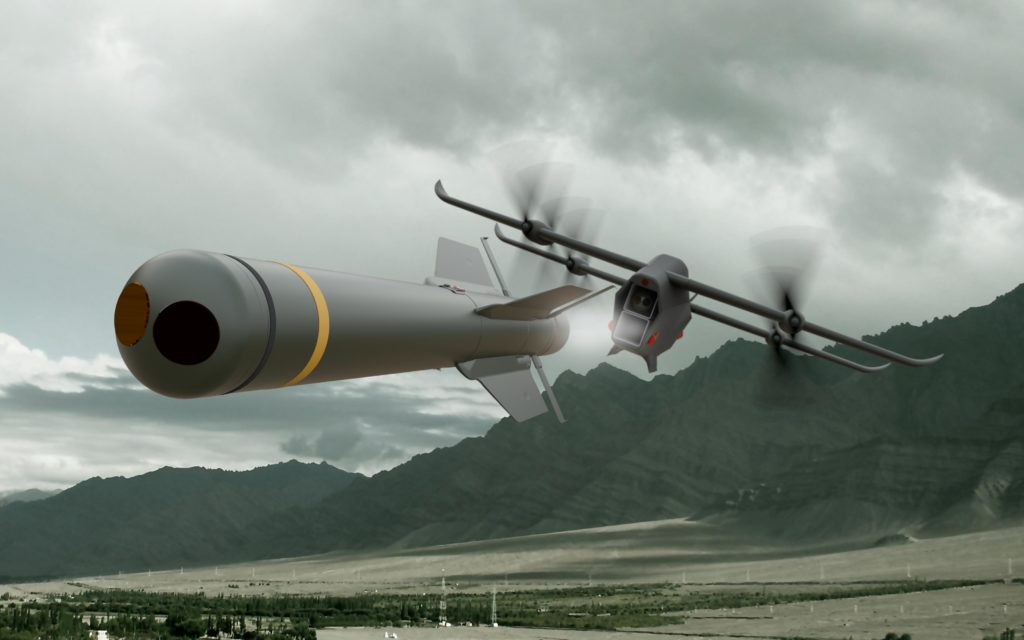
Outlook
Further miniaturisation, artificial intelligence and robotics are currently driving further development of the versatile shoulder-launched effectors. With a view to national and alliance defence, technologies are being developed to overcome modern armour and even active protection systems of combat vehicles. Networking with unmanned systems is another focus. For example, small drones can use real-time image data transmission to help the shooter keep an eye on the target even if the direct line of sight is interrupted. This makes it possible to react quickly to changes in the situation, such as the occurrence of previously undetected more dangerous targets, or late identification of friendly forces. Shoulder-launched multi-purpose weapons can also be used in conjunction with unmanned land and air systems. Conversely, unmanned systems – especially small and micro drones – will prove to be another target group for shoulder-launched weapons. Just as the PANZERFAUST supplemented the infantry toolbox in the past, a DROHNENFAUST (anti-drone bazooka) will probably do so in the foreseeable future.
Joint fire support may give the combat command of the future a wide range of available effectors, and there are already concepts for loitering effectors. Nevertheless, the ready-to-hand shoulder-launched multi-purpose weapon and the guided missile remain indispensable for infantry and dismounted combat forces.
Jan-P. Weisswange PhD works as a public relations officer in the defence industry. This article reflects his personal opinion.


